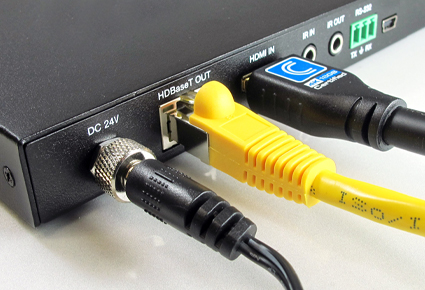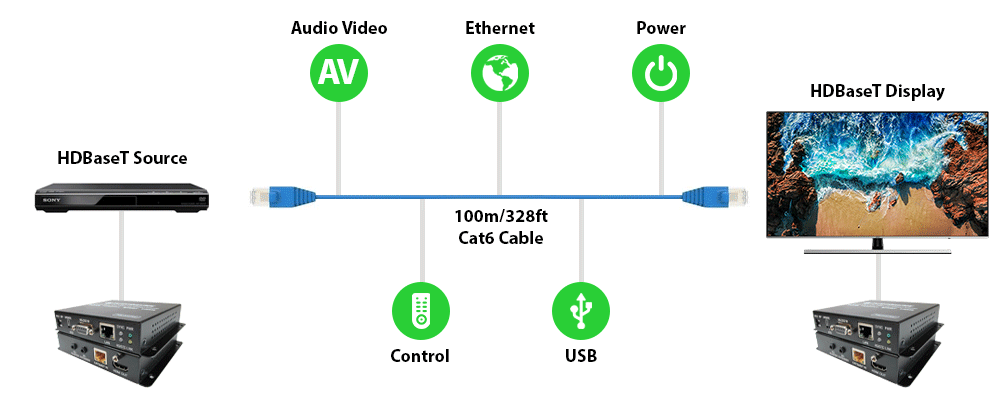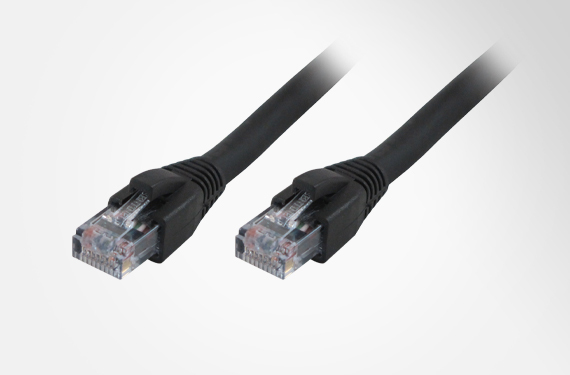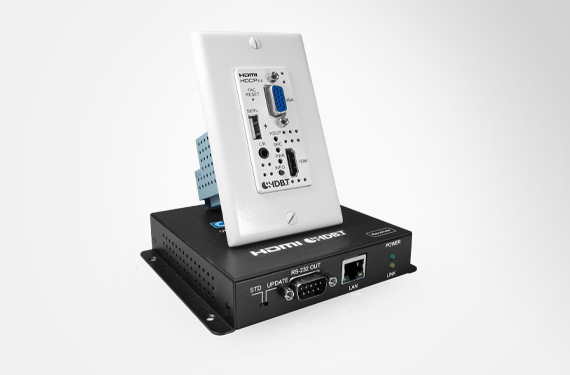HDBaseT™ is the global standard for the transmission of UHD video & audio, Ethernet, controls, USB and up to 100W of power over a single, long-distance cable. For audiovisual, consumer electronics, and even industrial PCs, this can be a simple category cable (Cat6 or above), for up to 100m/328ft. For medical and government applications, optical fiber is usually preferred, spanning several kilometers. For automotive, HDBaseT can be transmitted over a single unshielded twisted pair (UTP), for up to 15m/50ft, or any other commonly used media (such as STP, HSD, coaxial and fiber).
HDBaseT History
 The HDBaseT Alliance, incorporated on June 14, 2010 by Samsung Electronics, Sony Pictures Entertainment, LG Electronics and Valens, was developed to promote the HDBaseT standard originally created by Valens. The HDBaseT 1.0 specification was also finalized in June 2010. External accessories, such as dongles, were on the market in 2010 for devices not yet embedded with HDBaseT. Products were demonstrated at the 2013 Consumer Electronics Show.
The HDBaseT Alliance, incorporated on June 14, 2010 by Samsung Electronics, Sony Pictures Entertainment, LG Electronics and Valens, was developed to promote the HDBaseT standard originally created by Valens. The HDBaseT 1.0 specification was also finalized in June 2010. External accessories, such as dongles, were on the market in 2010 for devices not yet embedded with HDBaseT. Products were demonstrated at the 2013 Consumer Electronics Show.In mid-2013, the HDBaseT Alliance issued Spec 2.0, an update to the original specification, which enriches the HDBaseT offering to the pro-AV market, and enables a multimedia home connectivity solution. Spec 2.0 specifies the HDBaseT network protocol, defining the required adaptations across all layers of the OSI model, to provide the optimized services for time sensitive applications, such as high throughput video and audio. Spec 2.0 maintains all the features of Spec 1.0, but also adds networking, switching, and control-point capabilities such as flexible and fully utilized mesh topology, distributed routing, and end-to-end error handling, enabling multipoint-to-multipoint connectivity and multi-streaming. Spec 2.0 also embeds USB 2.0, enabling touch-screen functionality and keyboard-video-mouse (KVM) for no-latency transmission of ultra-high-definition audio and video.
HDBaseT Features
HDBaseT transmits uncompressed ultra-high-definition video (up to 4K), audio, power (up to 100W), Ethernet, USB, and other control communication (such as RS232 and IR) over category 5e cable or better up to 100 meters/330ft, using the same 8P8C modular connectors used for Ethernet.
HDBaseT Technology is capable to transmit video, audio, Ethernet, power and control signals over a signal category cable.
Video
HDBaseT delivers uncompressed video to a network of devices or as a point-to-point connection. Uncompressed video accurately renders gaming graphics and features such as electronic program guides, and does not degrade video quality or add latency.
It supports TV and PC video formats, including standard, enhanced, high-definition, ultra-HD (4K), and 3D video.
Due to bitrate limitations of 10.2 Gbit/s instead of the required 18 Gbit/s in the HDMI 2.0 specification, HDBaseT 2.0 can only support uncompressed 4K at 30 Hz with 4:4:4 color coding, or 4K at 60 Hz with 4:2:0 color coding, but not the full 60 Hz with 4:4:4 color.
Audio
Audio is a requirement for most consumer electronics devices. Audio is passed through the same media as video, so all standard HDMI formats are supported. However, HDBaseT does not support the Audio Return Channel, a feature found on HDMI 1.4.
Ethernet
HDBaseT supports the 100 Mbit/s version of Ethernet over twisted pair. This can provide Internet access, or enable televisions, stereos, computers and other CE devices to communicate with each other and access multimedia content, including video, pictures and music stored on the local network.
Power
Sending power over the same LAN cable gives the option to forgo plugging devices into the wall for power. HDBaseT uses a variation of Power over Ethernet (PoE) standard called "power over HDBaseT" to provide up to 100W of power to CE devices, such as Blu-ray players, monitors and TVs, and eliminate the need for external power cables. HDBaseT can power remote TVs and other devices up to 100 watts. A 60" TV connected via an HDBaseT-enabled Cat5e/6 cable requires no power source if your TV or device is capable of utilizing the power supplied by the HDBaseT unit.
Control signals
HDBaseT delivers control signals starting from CEC that operates basic functionality such as power-on, power-off and play/stop, to RS232/USB and IR commands, this is also referred to as HDBaseT 5 Play.

HDBaseT Versions
HDBaseT 1.0 Class A: HDBaseT 1.0 Class A extenders carry a 1080p/60fps HDMI 1.4 signal to a display, extending full 5Play audio, video, power, and control and Ethernet signals up to 100 meters. Because of the extra data received, the distance for a 4K UHD 2160p/30fps signal is typically shorter at 70 meters (depending on manufacturer), and the refresh rate is only 30fps. This potential limitation must be considered when designing an extender solution. The choice of extender can limit the ability to easily upgrade from 1080p to 4K resolution.
1080p 60fps

4K UHD 2160p 30fps

HDBaseT 1.0 Class B: HDBaseT 1.0 Class B extenders carry a 1080p/60fps HDMI 1.4 signal to a display, extending audio, video, and power and control signals up to 70 meters. Again, because of the extra data required, the distance for a 4K UHD 2160p/30fps signal is typically shorter at 40 meters. Be sure to check manufacturer’s specifications.
1080p 60fps

4K UHD 2160p 30fps

HDBaseT 2.0 standard was released in August 2013, and in addition to supporting the 5Play feature set as in Spec 1.0, it brought forth new functionalities, such as multi-streaming, daisy-chaining, USB 2.0 support and fiber as a new transmission medium. The first Spec 2.0-compliant chipset was released to the market in June 2014, and the first Spec 2.0 products are being introduced to the market now.
1080p 60fps

4K UHD 2160p 30fps and 60fps

HDBaseT 3.0 specification was announced at InfoComm 2019, Orlando, FL on June 11th, 2019. The HDBaseT Alliance, the cross-industry association tasked with promoting and advancing the HDBaseT standard, is finalizing the HDBaseT Spec 3.0, the latest and most advanced version of the HDBaseT standard. Spec 3.0 builds upon the definitions stipulated in Spec 2.0, with major changes in the physical layer (PHY) and USB outlining. In addition, Spec 3.0 will bring additional improvements to other interfaces.
Backward compatible with previous specifications, Spec 3.0 includes:
• 16Gbps bandwidth over a single category cable, enabling distribution of fully uncompressed 4K@60Hz 4:4:4 for up to 100m/328ft
• Low power mode/standby mode
• Support for HDMI1.4, HDMI 2.0 and HDCP2.3
• Support of 1Gb Ethernet and enhanced USB2.0 bandwidth
You can expect to start seeing companies coming out with HDBaseT 3.0 products by mid-2021.
1080p 60fps

4K UHD 2160p 30fps

HDBaseT 1.0 Class B: HDBaseT 1.0 Class B extenders carry a 1080p/60fps HDMI 1.4 signal to a display, extending audio, video, and power and control signals up to 70 meters. Again, because of the extra data required, the distance for a 4K UHD 2160p/30fps signal is typically shorter at 40 meters. Be sure to check manufacturer’s specifications.
1080p 60fps

4K UHD 2160p 30fps

HDBaseT 2.0 standard was released in August 2013, and in addition to supporting the 5Play feature set as in Spec 1.0, it brought forth new functionalities, such as multi-streaming, daisy-chaining, USB 2.0 support and fiber as a new transmission medium. The first Spec 2.0-compliant chipset was released to the market in June 2014, and the first Spec 2.0 products are being introduced to the market now.
1080p 60fps

4K UHD 2160p 30fps and 60fps

HDBaseT 3.0 specification was announced at InfoComm 2019, Orlando, FL on June 11th, 2019. The HDBaseT Alliance, the cross-industry association tasked with promoting and advancing the HDBaseT standard, is finalizing the HDBaseT Spec 3.0, the latest and most advanced version of the HDBaseT standard. Spec 3.0 builds upon the definitions stipulated in Spec 2.0, with major changes in the physical layer (PHY) and USB outlining. In addition, Spec 3.0 will bring additional improvements to other interfaces.
Backward compatible with previous specifications, Spec 3.0 includes:
• 16Gbps bandwidth over a single category cable, enabling distribution of fully uncompressed 4K@60Hz 4:4:4 for up to 100m/328ft
• Low power mode/standby mode
• Support for HDMI1.4, HDMI 2.0 and HDCP2.3
• Support of 1Gb Ethernet and enhanced USB2.0 bandwidth
You can expect to start seeing companies coming out with HDBaseT 3.0 products by mid-2021.
HDBaseT Solutions from Comprehensive
Comprehensive offers a large selection of HDBaseT Solutions including HDBaseT Extenders, Splitters with HDBaseT technology and specialty HDBaseT cables.
HDBaseT FAQs
Q: How does HDBaseT work?
A: HDBaseT uses an asymmetric method, sending audio, video, Ethernet, USB, controls and power from source to sink, but only 300 Mb are transferred back (Ethernet, controls, and possibly power). This asymmetric nature means that HDBaseT does not need to “pay” the protecting overhead for the video content that consumes most of the bandwidth. In other words, HDBaseT deals with error handling better than other technologies.
Q: What are the differences in HDBaseT Classes?
A: • Class A is the traditional HDBaseT product, able to support all 5Play features and transmits for up to 100m/328 ft.
• Class B is a more cost-effective solution for certain applications that do not require such distance and all features. It supports distances of up to 70m/230ft, and does not support Ethernet functionality.
• Class D is 1080p/30m/Cat6a
• Class E is fiber
Q: What is Long-Reach HDBaseT?
A: Long Reach mode allows for long-reach connectivity – up to 150 m – for lower resolutions of up to 720p. By checking vendors’ data sheets and collaterals, you can determine if a product supports long reach or not.
Q: Can I use any kind of category cable?
A: The HDBaseT Alliance specifies Cat5e or above for optimal performance.
Q: What is 5Play?
A: 5Play is the set of features delivered by HDBaseT: audio & video, USB, Ethernet, controls and power.
Q: What are the best practices for cabling as HDBaseT is concerned?
A: Since HDBaseT uses a regular category cable (LAN), any best practices for Ethernet cables also apply here. In general, you should be careful with cable handling (over bending, bundling, tight wraps, unnecessary untwisting), distances (refer to the manufacturers’ recommendations), sources of interference (keep cables away from power sources), and proper testing.
Q: Does HDBaseT support EDID and HDCP?
A: Yes, HDBaseT supports both for total protection of copyrighted content.
Q: What are the differences between HDBaseT Spec 1.0 and Spec 2.0?
A: The first HDBaseT standard specification was released in 2010. In mid-2013, the HDBaseT Alliance released Spec 2.0, which brought many new features to the original standard. Primarily, with Spec 2.0, HDBaseT is now a multipoint-to-multipoint technology, enabling networking of the whole home and/or business. Spec 2.0 brings a plug-and-play solution for full connectivity.
From an architecture standpoint, Spec 1.0 addressed the physical and data link layers only of the generic communications OSI 7-layer model. HDBaseT 2.0 goes one step further and work on all the layers of the model.
In terms of features, Spec 2.0 brings:
• Native support for a series of interfaces, including USB 2.0, which translates into a smaller and simpler to implement switch;
• Multi-streaming & daisy-chaining
• Enhanced performance for 4K delivery over longer distances
• Introduction of HDBaseT over fiber
Q: Is HDBaseT a replacement for HDMI?
A: No. HDBaseT works with and supports HDMI. HDBaseT is fully HDMI-compliant. While HDMI transmits high definition video over very short distances – a handful of meters/feet, HDBaseT can extend signal transmission for up to 100m/328ft.
Q: What are the typical applications for HDBaseT?
A: HDBaseT is suitable for many applications, such as commercial deployments, residential and custom installations, digital signage, education, industrial PCs, healthcare, transportation, hospitality, broadcasting, and more.
Q: What kind of latency can I expect in video transmission?
A: Latency is the measurable time that it takes a signal to get from one point to another. HDBaseT adds virtually no latency to the signal – less than 10 microseconds over 100m of cable.
Q: What Ethernet is supported?
A: HDBaseT supports 100Mb Ethernet alongside the video, audio and other 5Play features being sent over the same cable.
Q: How is USB integrated into HDBaseT?
A: USB 2.0 is embedded in the HDBaseT chipset, enabling all functionalities that depend on USB, such as touch-screen, collaboration, KVM etc.
Q: What control features are supported?
A: HDBaseT enables several control signals, such as Consumer Electronic Controls (CEC), Recommended Standard 232 (RS-232), USB, and infrared (IR). IP control is also enabled due to the support of an Ethernet channel.
Q: What is the theoretical bandwidth of HDBaseT technology?
A: Testing concentrated on the effectiveness of the HDBaseT extenders at their maximum distance capability (shorter distances may have better performance) and was conducted using 1080p/60 video sources. HDBaseT enables the transmission of AV signals at speeds of 10.2 Gbits/sec and a frequency of 300 MHz
Q: Which video resolutions are supported by HDBaseT?
A: HDBaseT delivers full high definition, including 3D, and 2K/4K uncompressed video. HDBaseT supports all key HDMI 2.0 features, including EPG, CEC, EDID and HDCP.
Q: What is the power feature enabled by HDBaseT?
A: HDBaseT enables Power of HDBaseT (PoH), a variation of power over Ethernet (PoE). PoH enables up to 100W of DC power to be delivered over the same Cat cable, which is enough to power most end devices, such as large screen TVs.
Q: How does HDBaseT transmit power?
A: Power over HDBaseT (POH) enables the transfer of DC power in conjunction with data signals over a single Ethernet cable to a distance of up to 100m. The POH standard is based on the IEEE 802.3at standard with the appropriate modifications to enable safe delivery of up to 100 watts (W) across all four-pairs of the Ethernet cable. Four-pair powering is the key to delivering more power with greater efficiency. Defined in the latest high-power PoE standards, four-pair powering gives powered devices two power interfaces so they can receive twice the power of earlier two-pair solutions by using all four pairs of Ethernet cable.
Q: Does Comprehensive offer HDBaseT products?
A: Yes, Comprehensive offers a large selection of HDBaseT products including HDBaseT Extenders, Splitters with HDBaseT technology and specialty HDBaseT cables.
A: HDBaseT uses an asymmetric method, sending audio, video, Ethernet, USB, controls and power from source to sink, but only 300 Mb are transferred back (Ethernet, controls, and possibly power). This asymmetric nature means that HDBaseT does not need to “pay” the protecting overhead for the video content that consumes most of the bandwidth. In other words, HDBaseT deals with error handling better than other technologies.
Q: What are the differences in HDBaseT Classes?
A: • Class A is the traditional HDBaseT product, able to support all 5Play features and transmits for up to 100m/328 ft.
• Class B is a more cost-effective solution for certain applications that do not require such distance and all features. It supports distances of up to 70m/230ft, and does not support Ethernet functionality.
• Class D is 1080p/30m/Cat6a
• Class E is fiber
Q: What is Long-Reach HDBaseT?
A: Long Reach mode allows for long-reach connectivity – up to 150 m – for lower resolutions of up to 720p. By checking vendors’ data sheets and collaterals, you can determine if a product supports long reach or not.
Q: Can I use any kind of category cable?
A: The HDBaseT Alliance specifies Cat5e or above for optimal performance.
Q: What is 5Play?
A: 5Play is the set of features delivered by HDBaseT: audio & video, USB, Ethernet, controls and power.
Q: What are the best practices for cabling as HDBaseT is concerned?
A: Since HDBaseT uses a regular category cable (LAN), any best practices for Ethernet cables also apply here. In general, you should be careful with cable handling (over bending, bundling, tight wraps, unnecessary untwisting), distances (refer to the manufacturers’ recommendations), sources of interference (keep cables away from power sources), and proper testing.
Q: Does HDBaseT support EDID and HDCP?
A: Yes, HDBaseT supports both for total protection of copyrighted content.
Q: What are the differences between HDBaseT Spec 1.0 and Spec 2.0?
A: The first HDBaseT standard specification was released in 2010. In mid-2013, the HDBaseT Alliance released Spec 2.0, which brought many new features to the original standard. Primarily, with Spec 2.0, HDBaseT is now a multipoint-to-multipoint technology, enabling networking of the whole home and/or business. Spec 2.0 brings a plug-and-play solution for full connectivity.
From an architecture standpoint, Spec 1.0 addressed the physical and data link layers only of the generic communications OSI 7-layer model. HDBaseT 2.0 goes one step further and work on all the layers of the model.
In terms of features, Spec 2.0 brings:
• Native support for a series of interfaces, including USB 2.0, which translates into a smaller and simpler to implement switch;
• Multi-streaming & daisy-chaining
• Enhanced performance for 4K delivery over longer distances
• Introduction of HDBaseT over fiber
Q: Is HDBaseT a replacement for HDMI?
A: No. HDBaseT works with and supports HDMI. HDBaseT is fully HDMI-compliant. While HDMI transmits high definition video over very short distances – a handful of meters/feet, HDBaseT can extend signal transmission for up to 100m/328ft.
Q: What are the typical applications for HDBaseT?
A: HDBaseT is suitable for many applications, such as commercial deployments, residential and custom installations, digital signage, education, industrial PCs, healthcare, transportation, hospitality, broadcasting, and more.
Q: What kind of latency can I expect in video transmission?
A: Latency is the measurable time that it takes a signal to get from one point to another. HDBaseT adds virtually no latency to the signal – less than 10 microseconds over 100m of cable.
Q: What Ethernet is supported?
A: HDBaseT supports 100Mb Ethernet alongside the video, audio and other 5Play features being sent over the same cable.
Q: How is USB integrated into HDBaseT?
A: USB 2.0 is embedded in the HDBaseT chipset, enabling all functionalities that depend on USB, such as touch-screen, collaboration, KVM etc.
Q: What control features are supported?
A: HDBaseT enables several control signals, such as Consumer Electronic Controls (CEC), Recommended Standard 232 (RS-232), USB, and infrared (IR). IP control is also enabled due to the support of an Ethernet channel.
Q: What is the theoretical bandwidth of HDBaseT technology?
A: Testing concentrated on the effectiveness of the HDBaseT extenders at their maximum distance capability (shorter distances may have better performance) and was conducted using 1080p/60 video sources. HDBaseT enables the transmission of AV signals at speeds of 10.2 Gbits/sec and a frequency of 300 MHz
Q: Which video resolutions are supported by HDBaseT?
A: HDBaseT delivers full high definition, including 3D, and 2K/4K uncompressed video. HDBaseT supports all key HDMI 2.0 features, including EPG, CEC, EDID and HDCP.
Q: What is the power feature enabled by HDBaseT?
A: HDBaseT enables Power of HDBaseT (PoH), a variation of power over Ethernet (PoE). PoH enables up to 100W of DC power to be delivered over the same Cat cable, which is enough to power most end devices, such as large screen TVs.
Q: How does HDBaseT transmit power?
A: Power over HDBaseT (POH) enables the transfer of DC power in conjunction with data signals over a single Ethernet cable to a distance of up to 100m. The POH standard is based on the IEEE 802.3at standard with the appropriate modifications to enable safe delivery of up to 100 watts (W) across all four-pairs of the Ethernet cable. Four-pair powering is the key to delivering more power with greater efficiency. Defined in the latest high-power PoE standards, four-pair powering gives powered devices two power interfaces so they can receive twice the power of earlier two-pair solutions by using all four pairs of Ethernet cable.
Q: Does Comprehensive offer HDBaseT products?
A: Yes, Comprehensive offers a large selection of HDBaseT products including HDBaseT Extenders, Splitters with HDBaseT technology and specialty HDBaseT cables.
For more information on HDBaseT, please visit www.hdbaset.org



